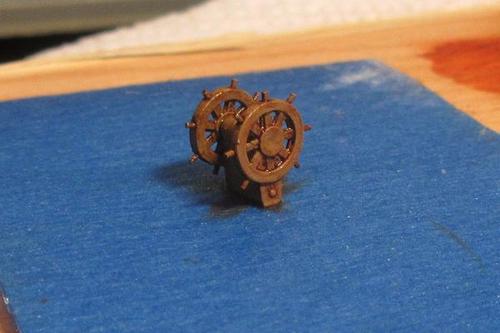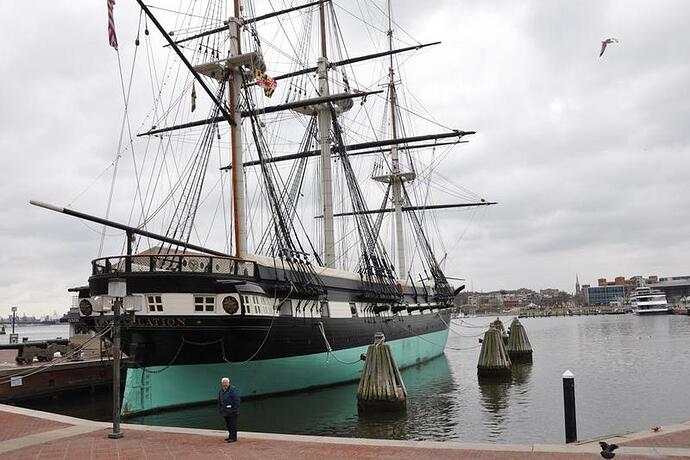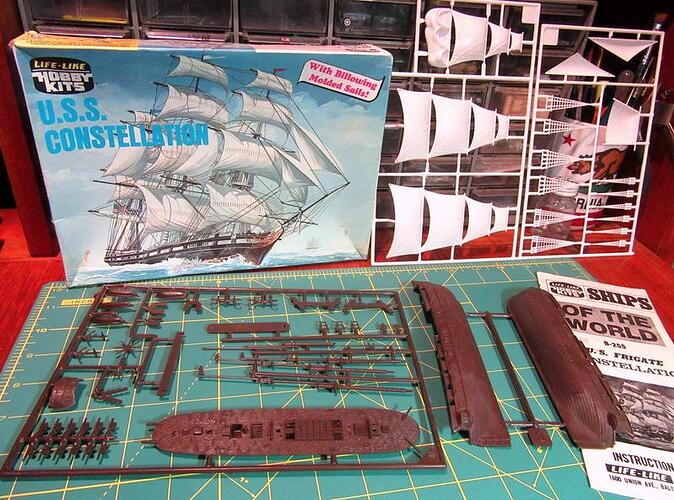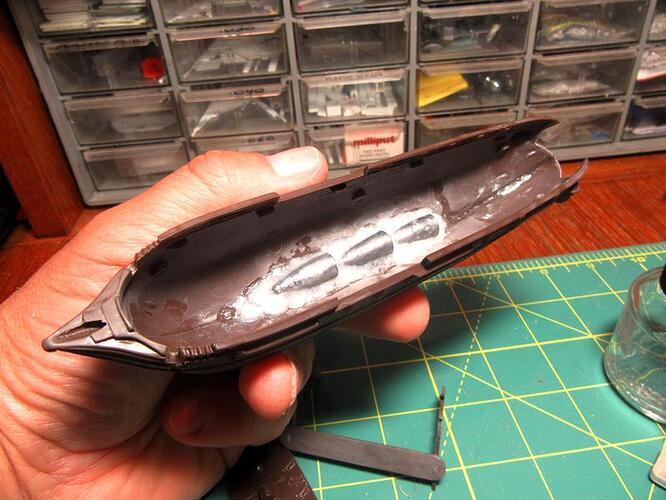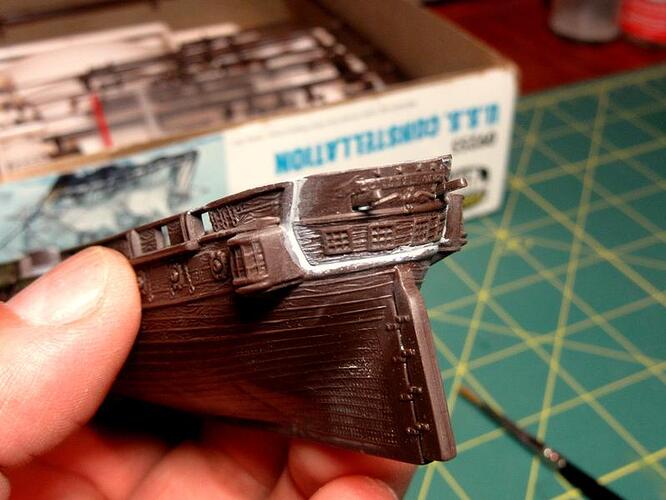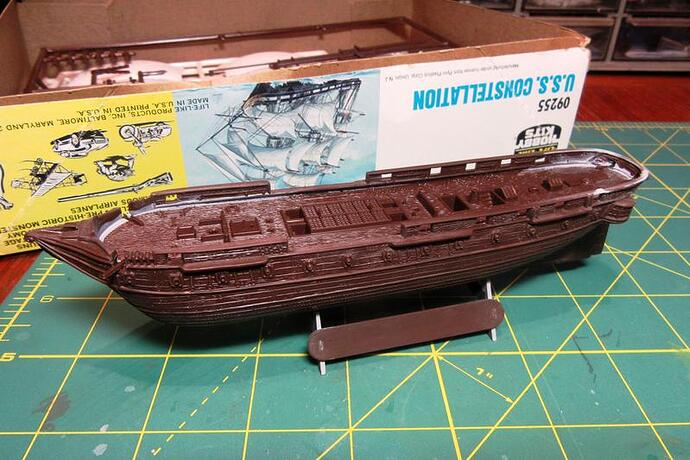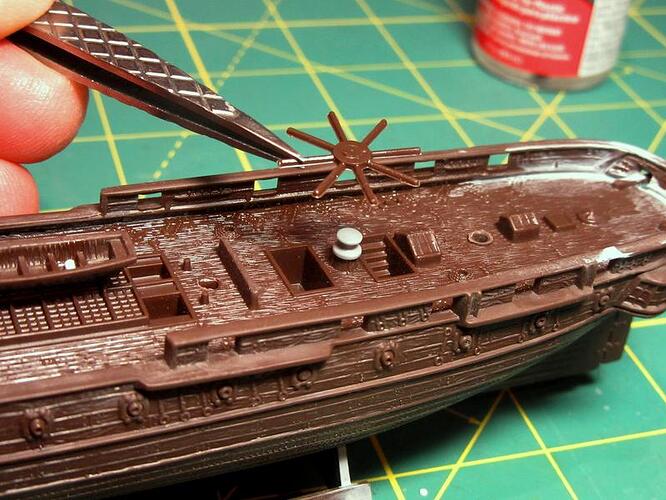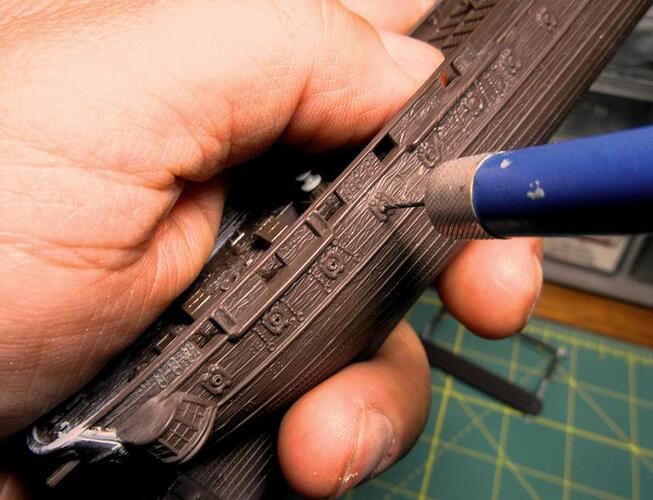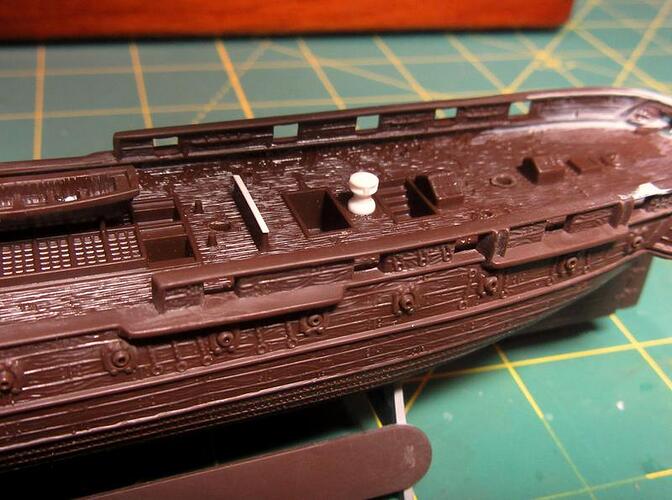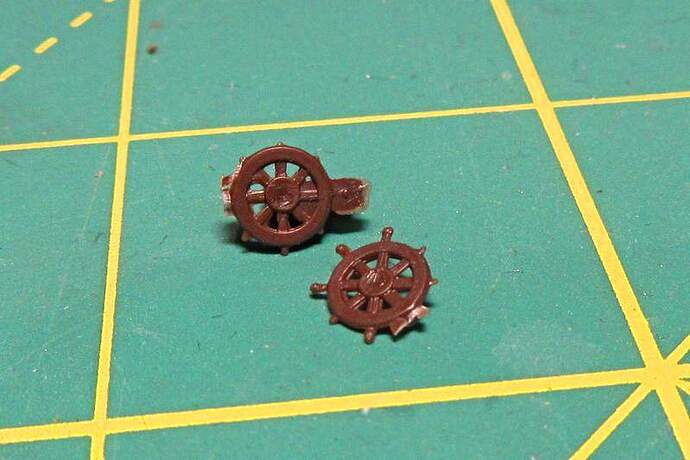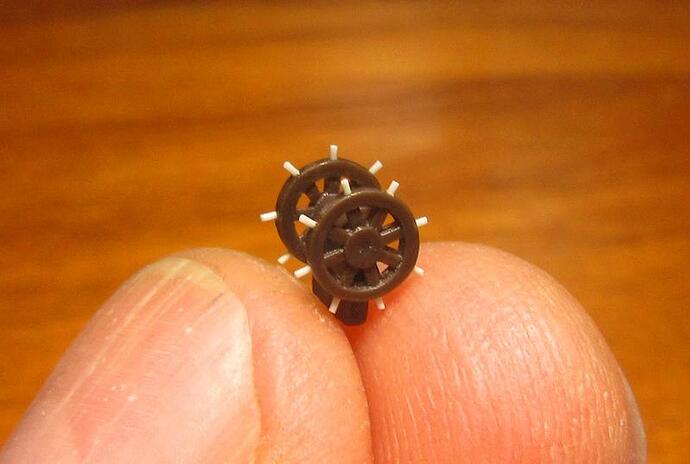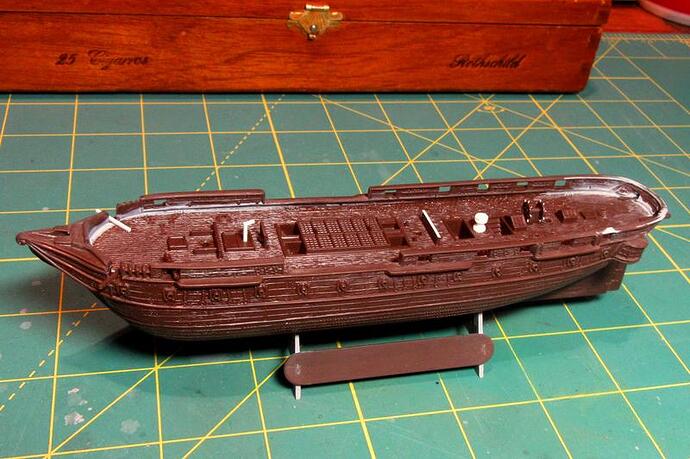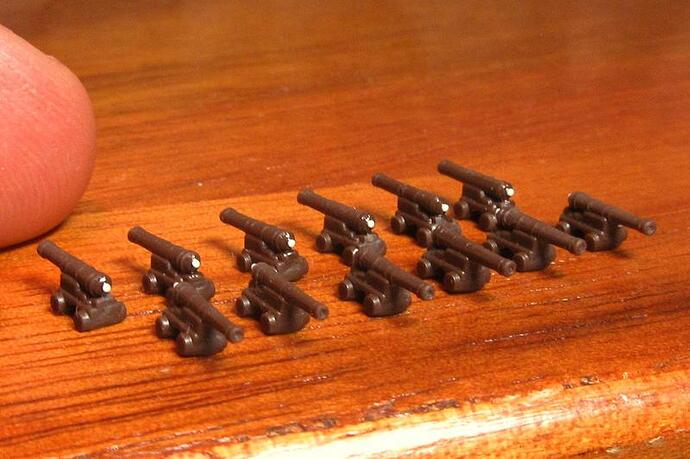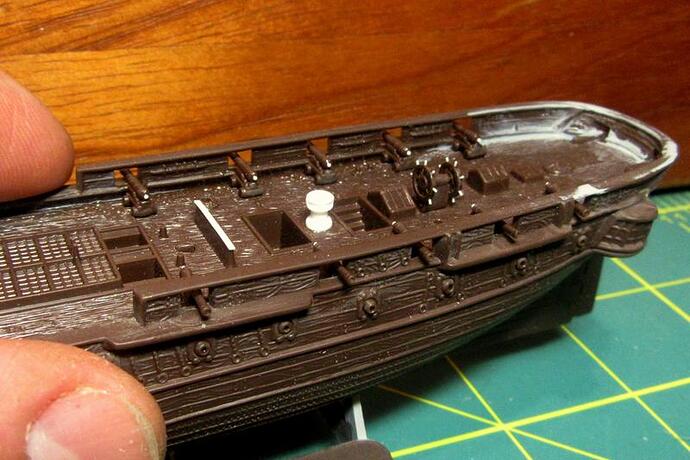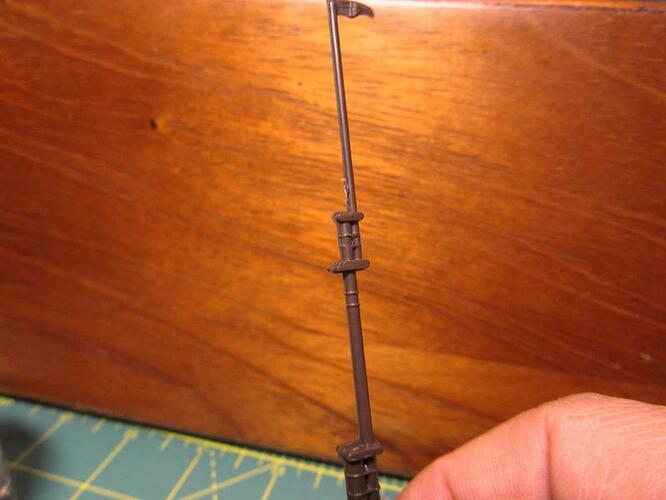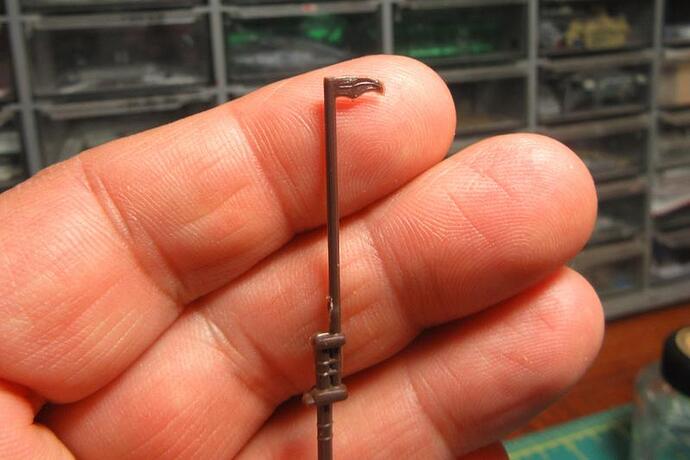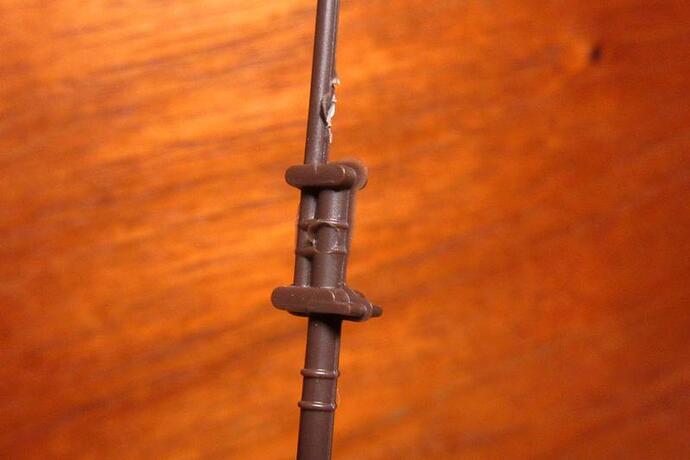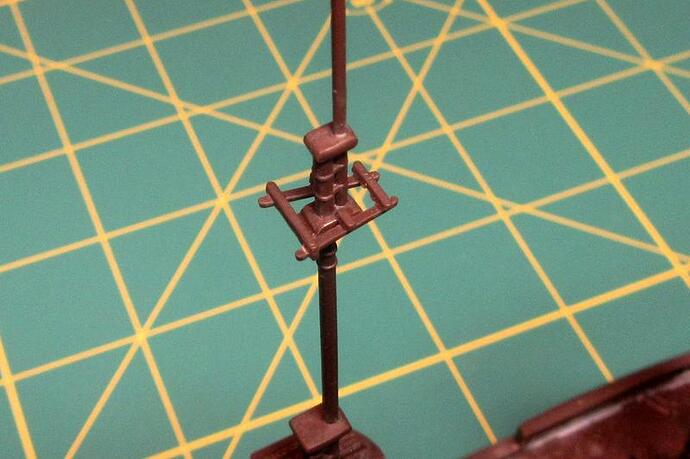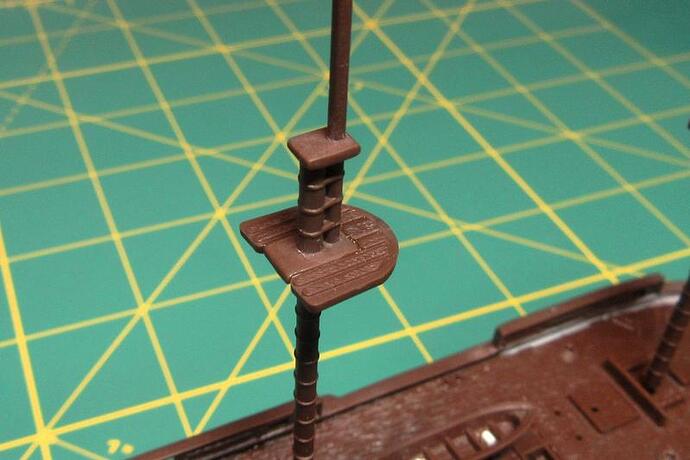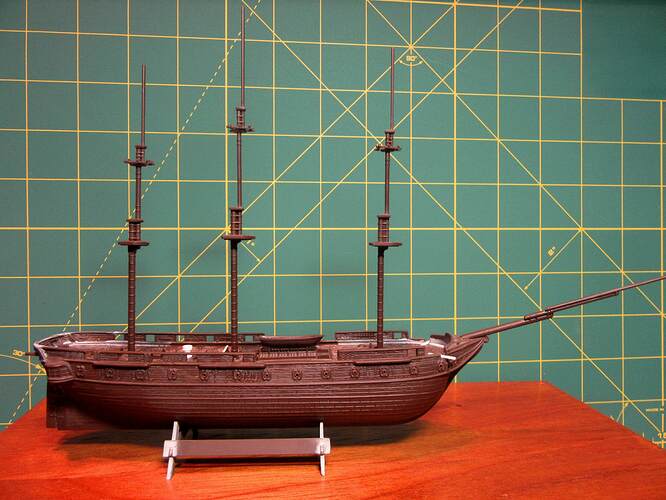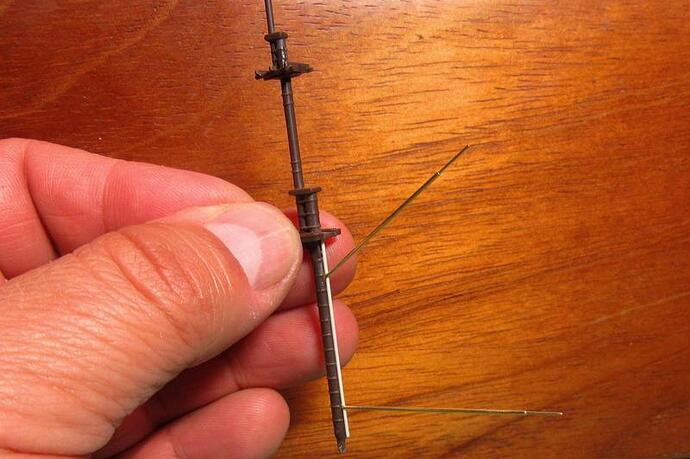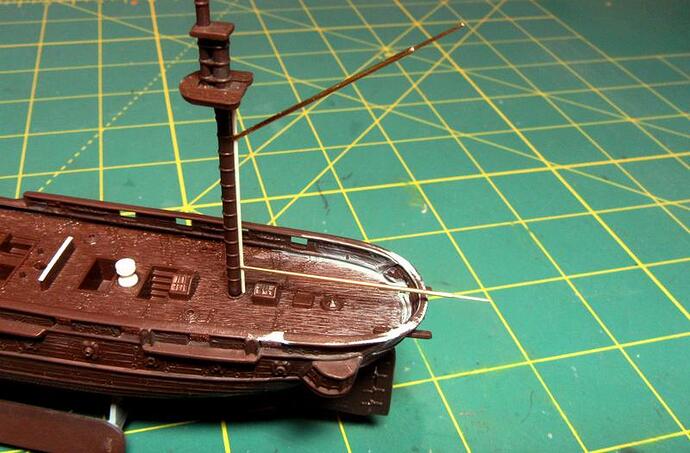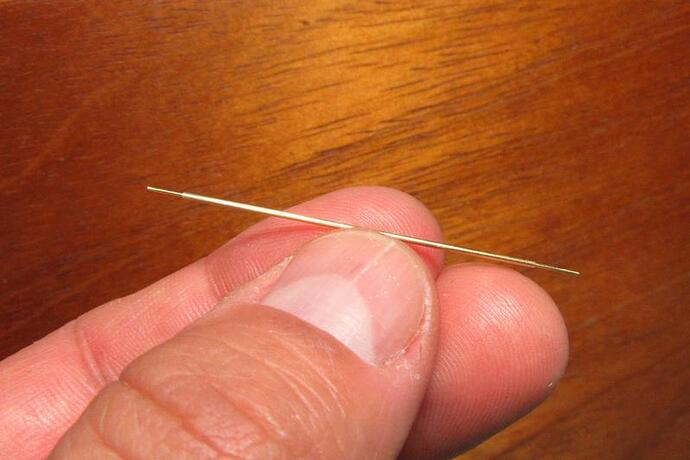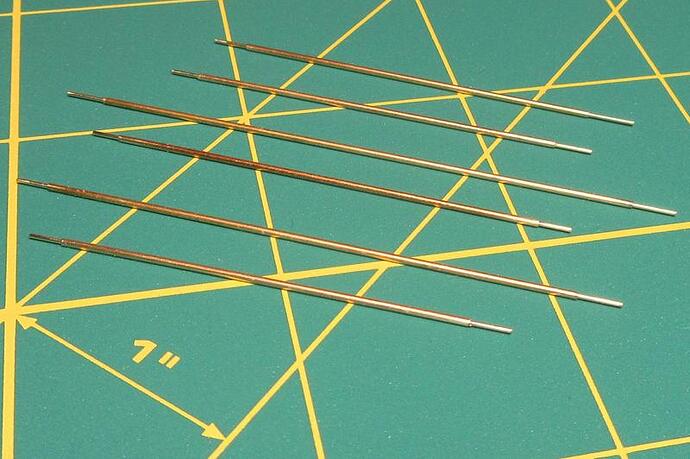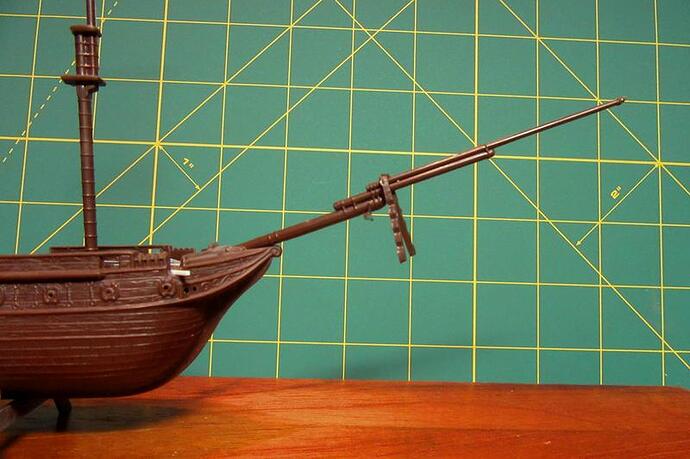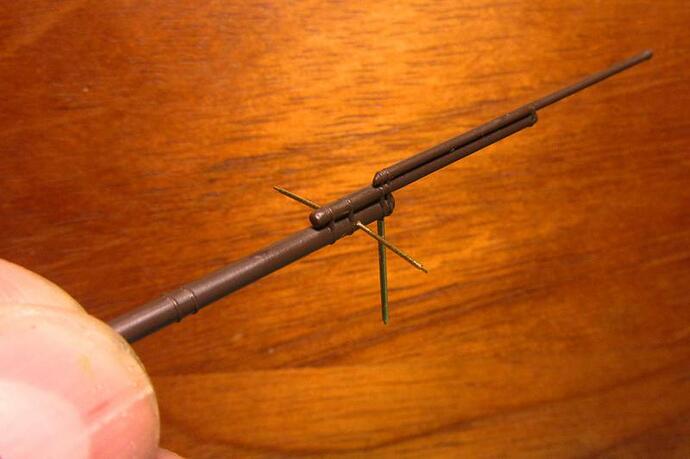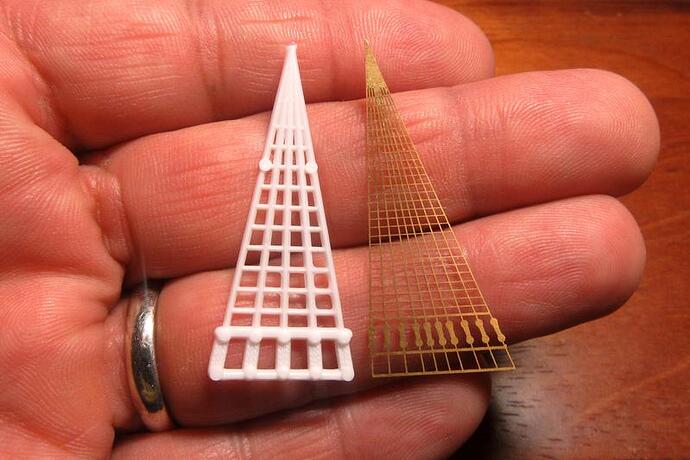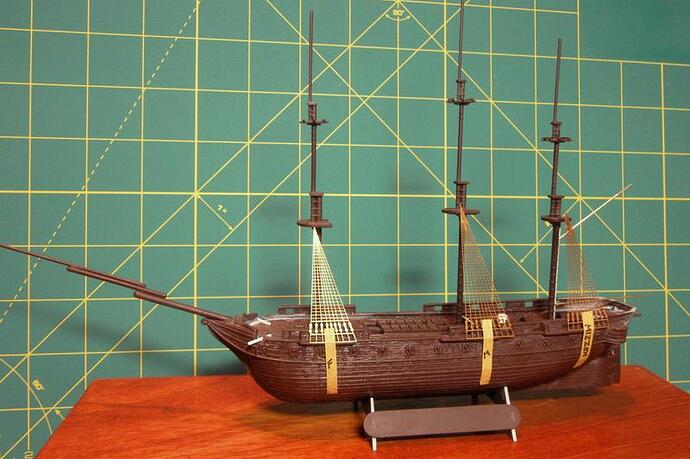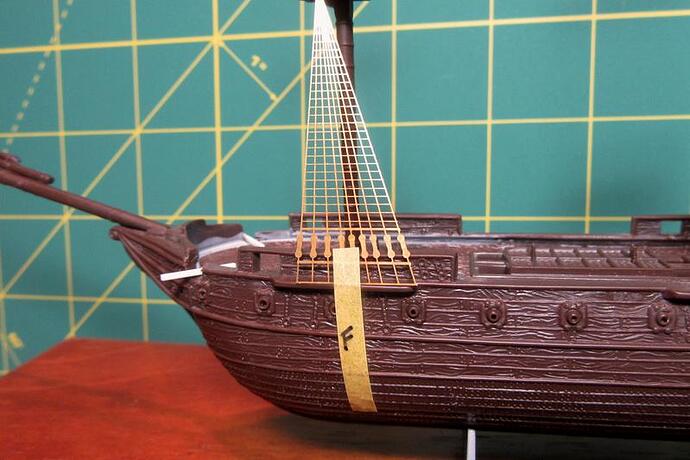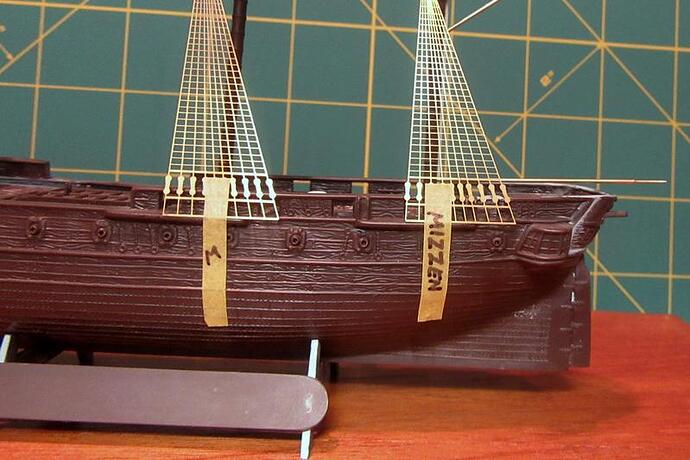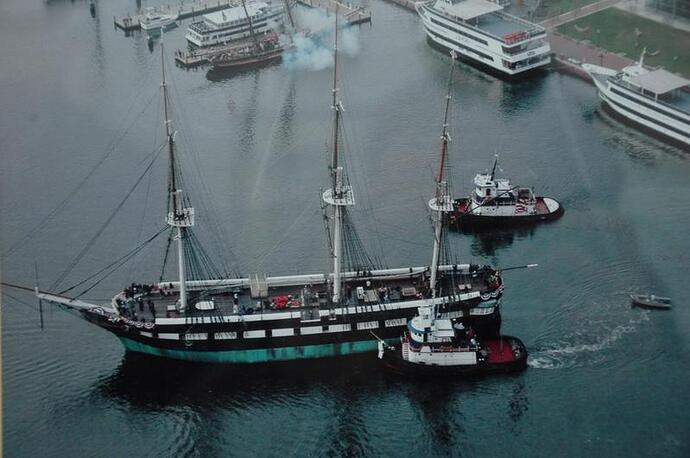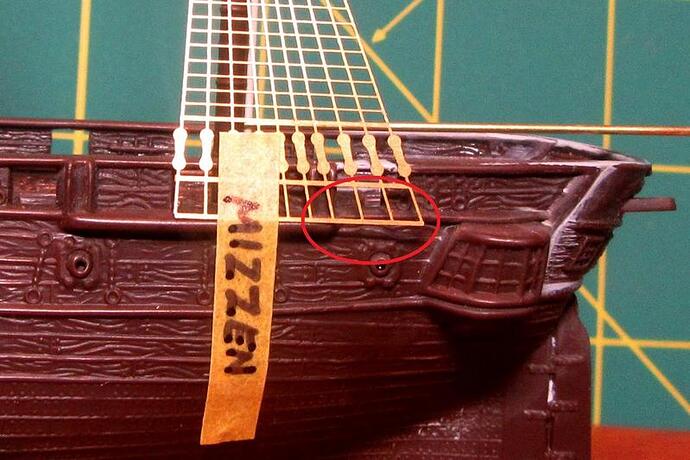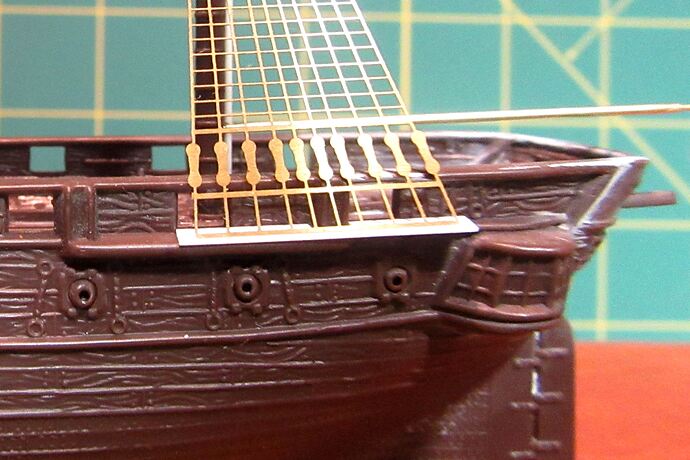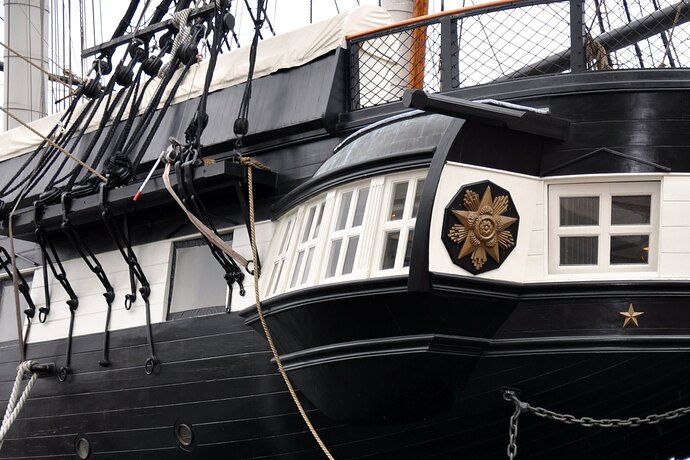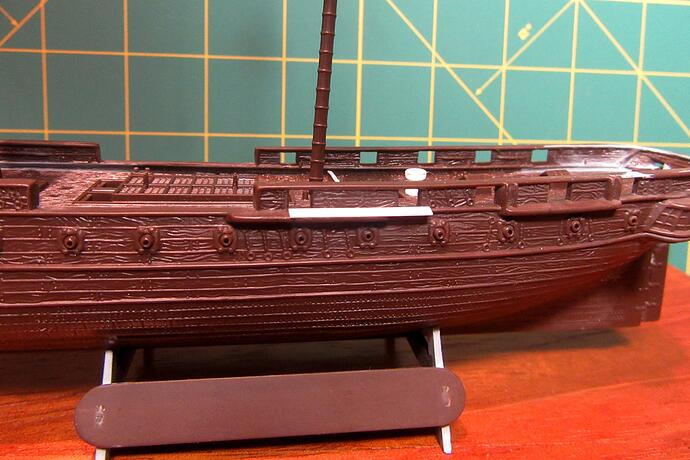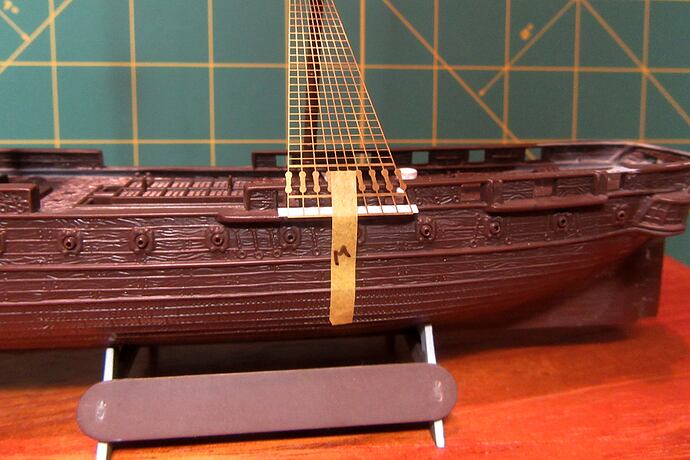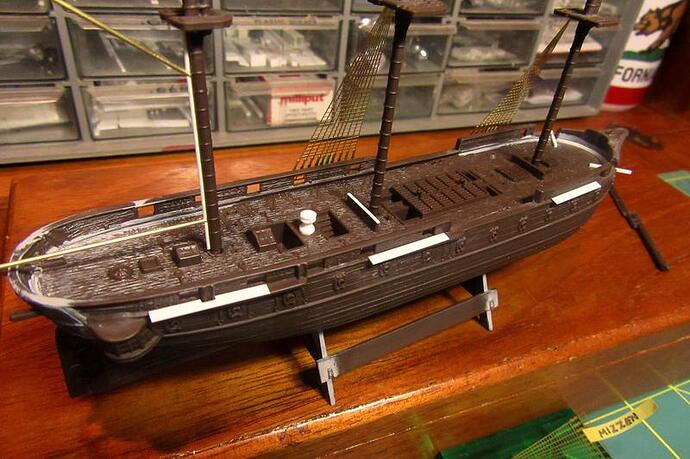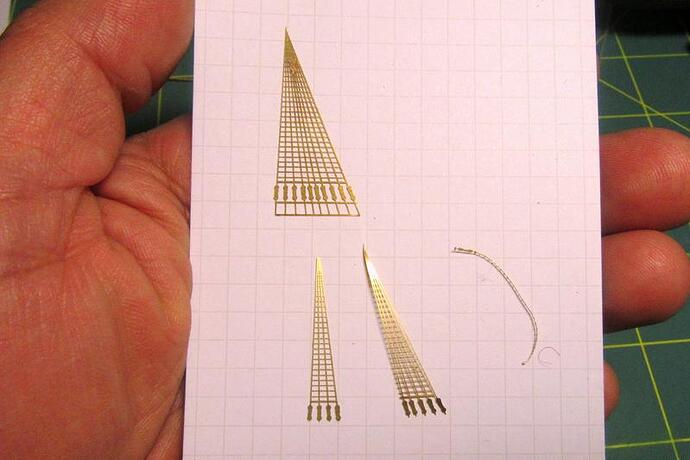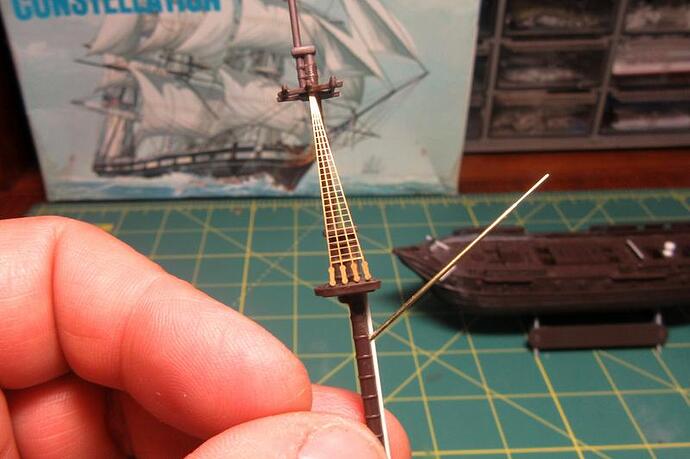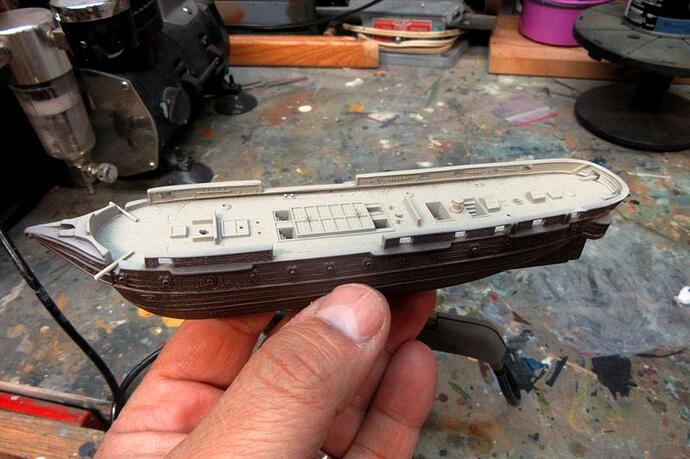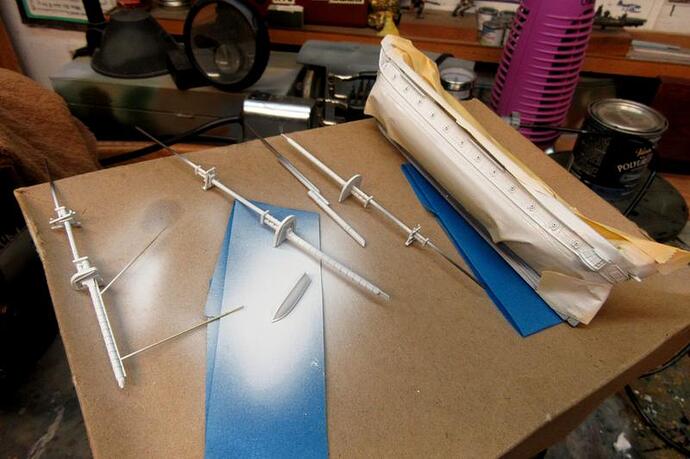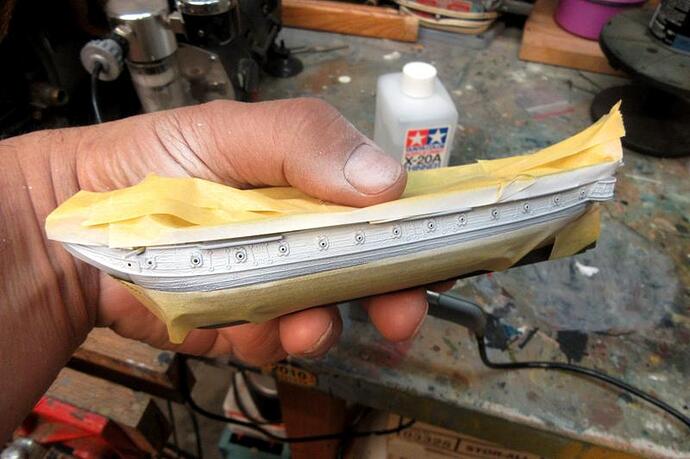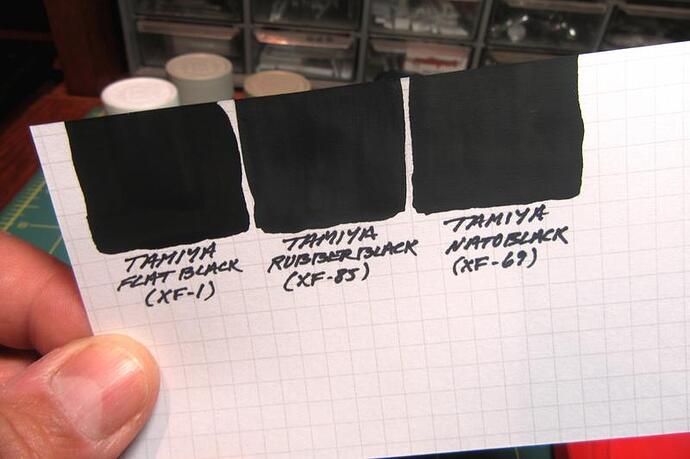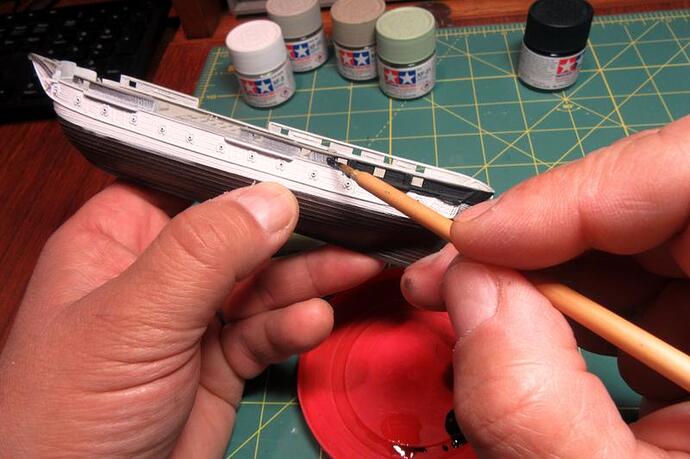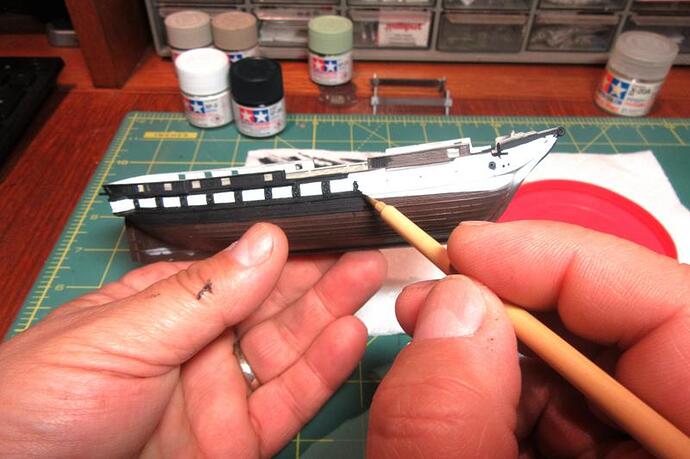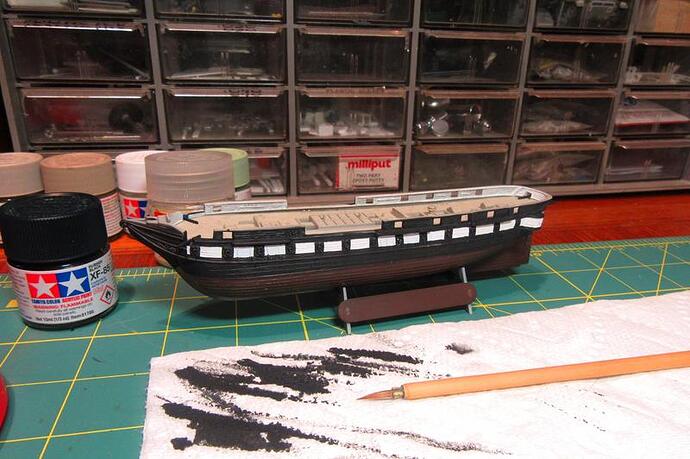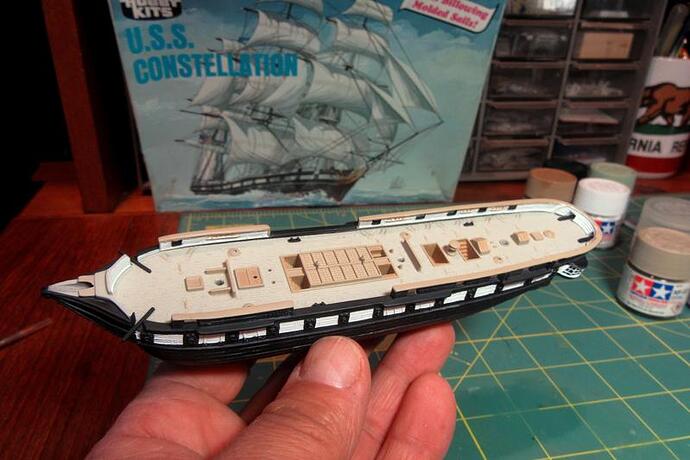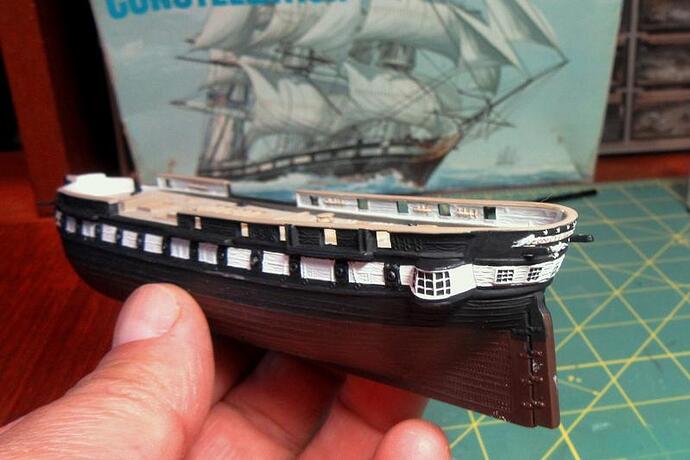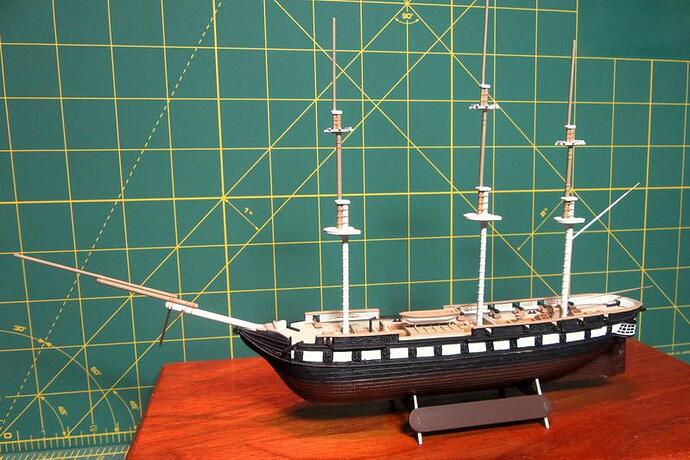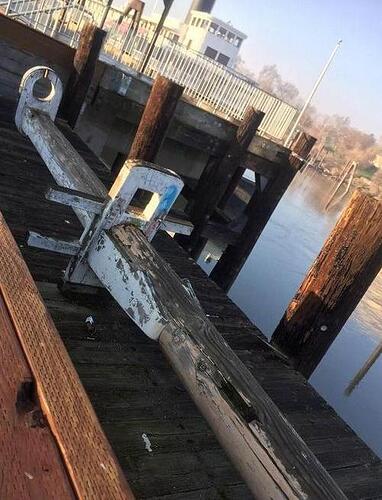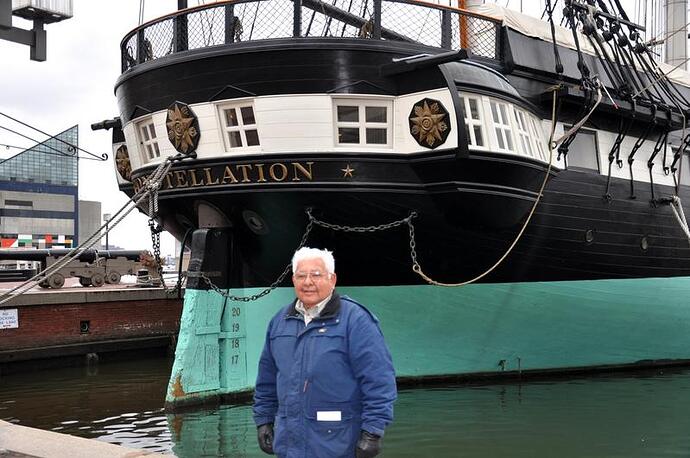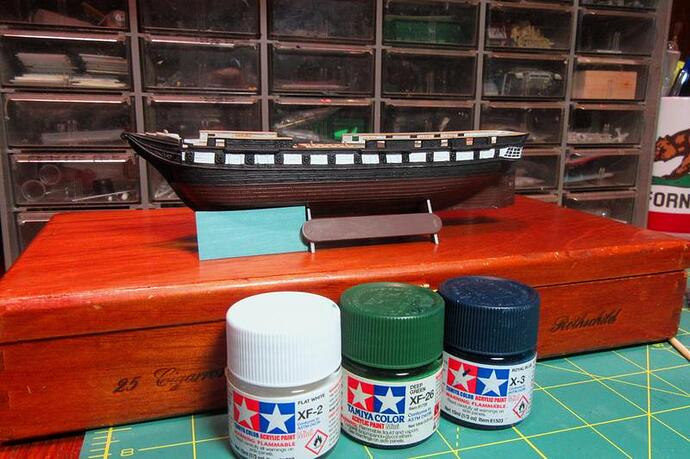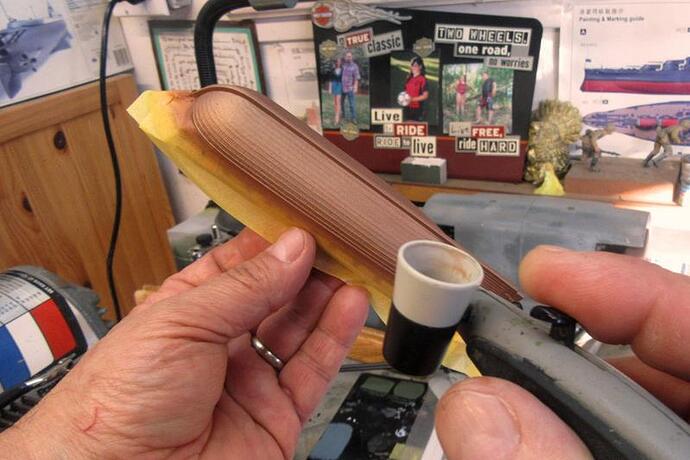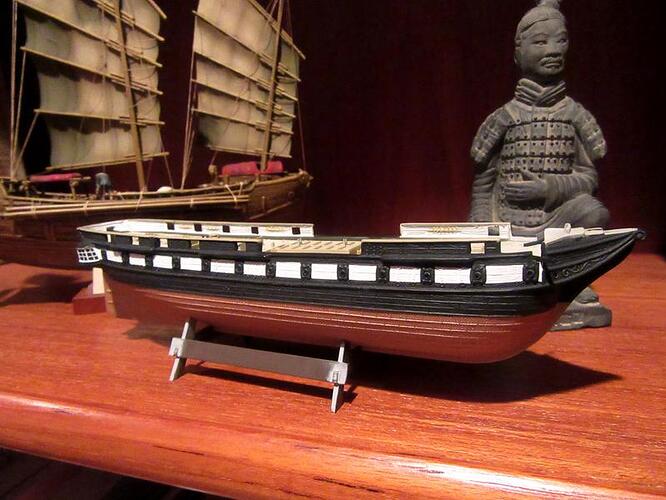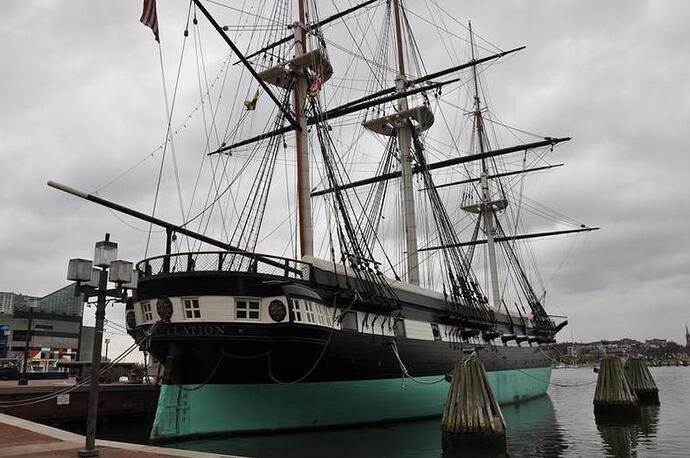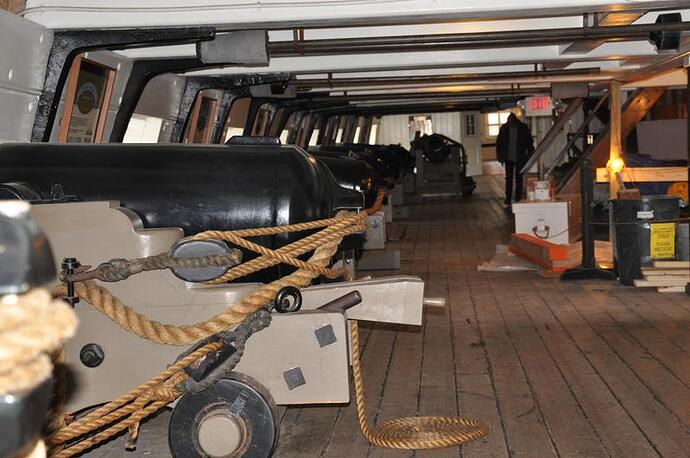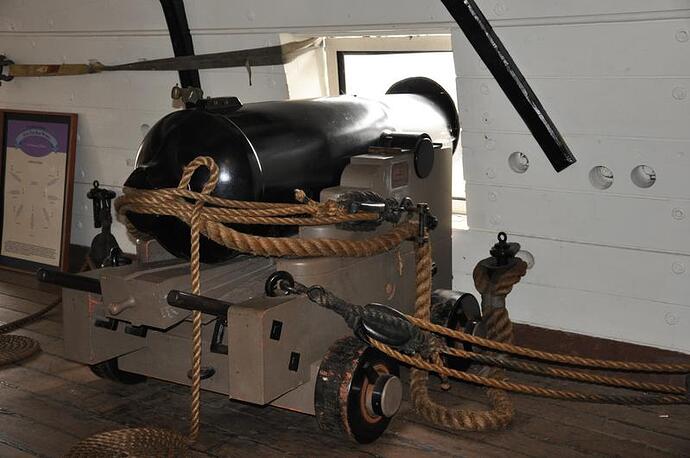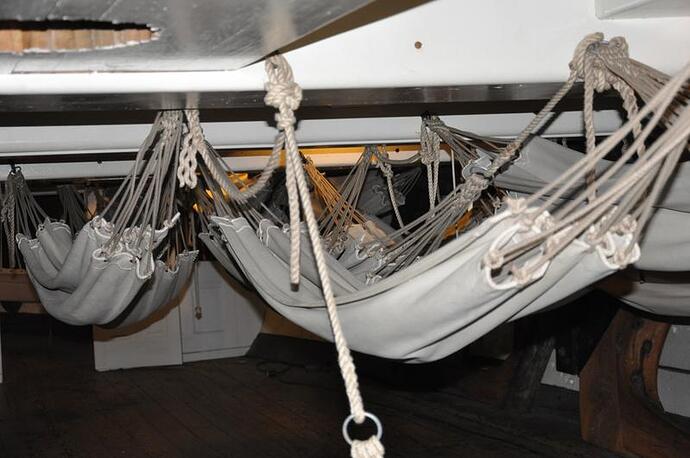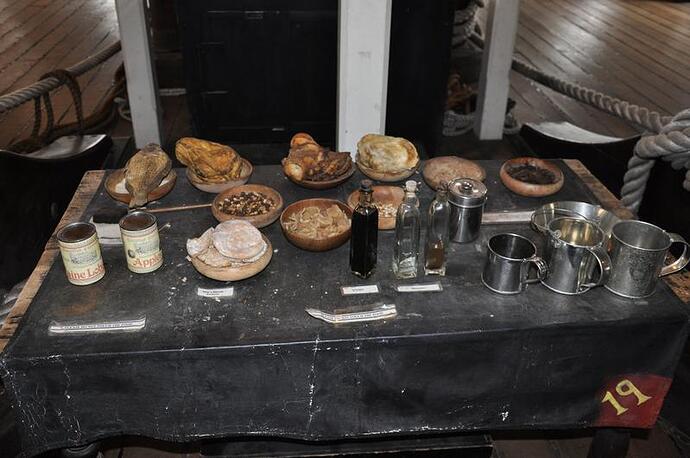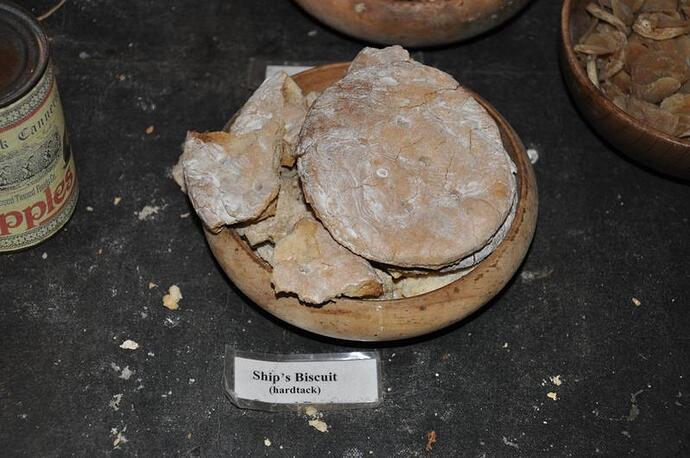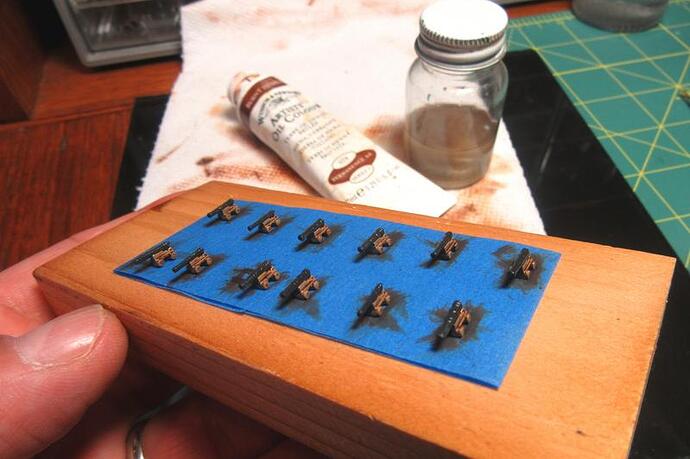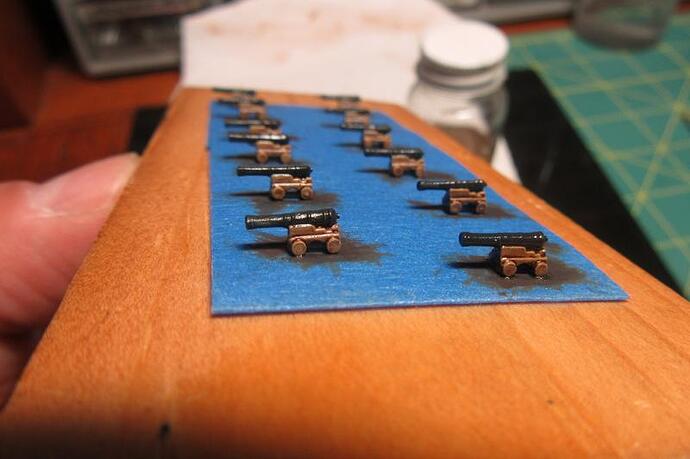Hi all!
Having hit a minor snag in my IJN Hatsuzuki build, I thought I’d take a break and return to a build I began (and suspended) a couple of years ago, Pyro’s U.S.S. Constellation model from 1966. Here’s a repost of the progress I’ve made on her thus far:
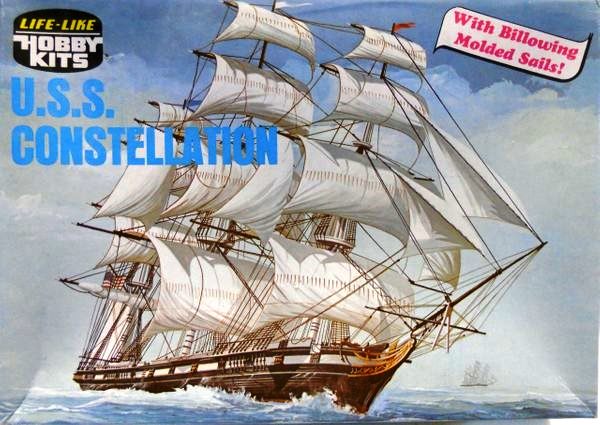
The U.S.S. Constellation is a sloop-of-war, the last sail-only warship built for the United States Navy. Commissioned in 1855, she served for close to a century before finally being retired in 1954. During her long career Constellation performed a wide variety of duties including trade protection, Civil War blockade duty, cargo transport, and as a training ship. She brought humanitarian relief for the 1879 Irish famine, and even served as the reserve flagship for the then-Commander in Chief of the Atlantic Fleet, Admiral Ernest J. King, in 1941. Perhaps Constellation’s most significant contribution was early in her career with the slave trade patrol, during which she captured three slave ships and freed a total of 705 slaves. She is now preserved as a museum ship in Baltimore, Maryland.
I happened to pick up a rather battered copy of Life-Like’s reissue of the Pyro kit on the cheap a while back, but the real appeal of this model is as a reminder of a trip to Washington, D.C. and Baltimore with my dad a few years ago (that’s him in the foreground). We made the trip without the wives or kids, so we were able to do all the “boring” guy activities – USS Constellation, National Museum of the U.S. Navy at the Washington Navy Yard, USCG Taney, the Chesapeake light ship, junk food dinners every night – without fear of trying the patience of loved ones. It was great! _________________________________________________________________________________
Dating from 1972, Life-Like’s reissue of Pyro’s 1966 U.S.S. Constellation kit isn’t exactly new, and over the years the box has had its share of bumps – but the parts look as pristine as the day they were manufactured!
In the spirit of Pyro’s simplified, quick-build model kits, I don’t plan to go crazy superdetailing this one. Maybe add some details, correct a few shortcomings… but mostly I just want to have fun with the build.
One change was to add some lead weights to the inside of the hull for a bit of heft to make it more stable on its display cradle.
The fifty year old molds are not today’s state of the art, but the parts fit reasonably well with the help of a little filler.
I managed to snap off and lose the starboard bower anchor catshead while assembling the hull, but a length of .030 X .030 inch strip made for a quick repair.
Pyro’s uncomplicated four-piece hull assembles quickly and easily.
Pyro depicted the capstan on the spar deck as a simplified pedestal onto which a separate capstan head, with its removable bars in place, was to be fitted.
The representation was pretty basic, so I substituted a capstan raided from a 1/350 Zvezda Varyag kit.
I didn’t add the removable bars to the new part, though.
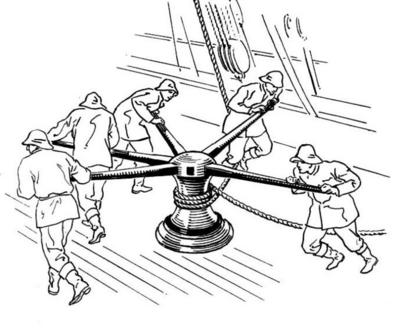
Their deployment didn’t make sense to me as the hatch covers are not in place – the men turning the capstan would have fallen into the ship!
The ports on the hull are molded as open with the gun muzzles visible. Cutting open the kit gunports, fabricating a gundeck inside and fitting cannon would have been a sizeable task – well beyond the scope of what I want to do with this simple kit.
I contented myself with drilling out the cannon muzzles.
Also, although the Zvezda Varyag capstan was definitely an improvement over the original kit representation, it too was replaced with one from a Revell U.S.S. Olympia kit that I liked even better.
I nicked the adjacent fife rail while trimming away the capstan base molded to the deck; the white plastic strip is a repair.
Finishing the deck clean up, I made a simple replacement for the uninspiring kit galley stovepipe from plastic rod.
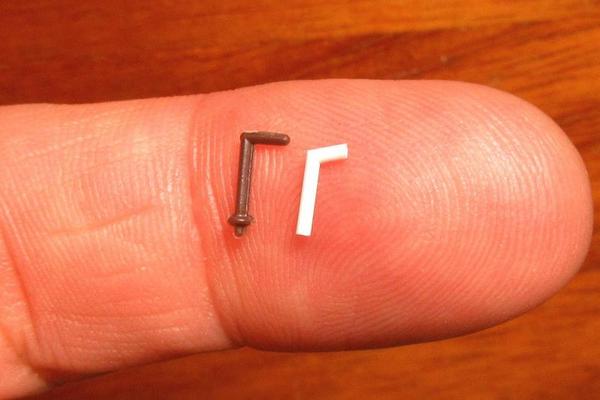
The kit helm parts, on the other hand, were well designed, but it was the plastic injection technology of the 1960s that let them down; both parts were “short shot” with most of the grab handles on the wheel perimeters incompletely molded.
After cleaning up the wheels, tiny lengths Plastruct .010 inch styrene rod replaced the poorly molded handles.
The rebuilt wheels should look good under a coat of paint.
With these and the other minor fixes completed, it is on to the deck cannon!
In addition to the cannon muzzles molded into the hull sides, the kit also comes with twelve separately molded weapons for the topside weather deck.
Although the U.S.S. Constellation museum ship no longer has these cannon on deck, I opted to include them on the model anyway because the kit parts are so nicely done. Unfortunately the tiny parts, though well mastered, suffer from severe mold misalignment which meant the cleanup process destroyed some of the detail. They still look pretty nice, though.
I upgraded them slightly by drilling out the muzzles and adding the knobs at the back ends of the barrels using .018 inch discs cut from .010 inch plastic.
Test fitted in place, they add a pleasing busyness to the deck.
The masts are next. Having designed the kit back in the 1960s with young modelers in mind, Pyro simplified the composite, multi-step masts into single parts, and the complex bowsprit was reduced to a mere three parts.
The moldings are basically accurate and surprisingly convincing – although some details like the molded-in flags were less successful!
The biggest problem with these parts came from the low pressure plastic injection molding technology of the era; the combination of heavy sprue attachment points, knock out pin marks, and mold misalignment on these fragile parts made for some pretty tedious cleanup.
My kids were able to get entirely through the ‘Happytime Murders’ puppet movie before I had the three masts prepped to receive their platforms!
Once cleaned up and with the platforms attached, though, the test fitted masts don’t look bad at all.
In typical Pyro style, the spars for each mast were molded integrally with the billowing sails. Since I want to depict the ship as she appears today as a museum, these sails won’t be needed.
Rather than try to remove the spars from the sail parts, I opted to construct new ones from brass tube and rod. The tapered yards would be simulated with .8mm brass tubes (Lion Roar LT0018) combined with .019 inch brass wire (Detail Associates 2506) slipped inside and left protruding from the ends.
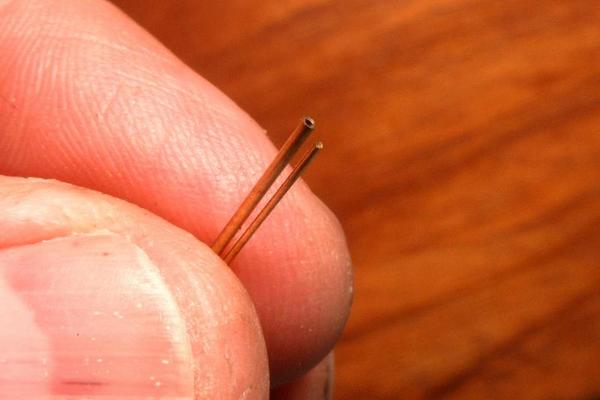
The first were the gaff and boom for the spanker sail. I began by drilling locator holes in the mizzen to accept the .019 inch brass wire.
After cutting angled gaff and horizontal boom pieces of the appropriate lengths, they were secured to the mast with dabs of cyanoacrylate. The spencer (trysail) mast was then added using lengths of Plastruct .025 inch round white plastic rod.
I also made six .8mm tube/.019 inch wire yards – two for each of the three masts. Although period paintings (and Pyro’s original kit parts) indicate that the Constellation actually shipped up to twelve these spars in service, the present day museum has only this abbreviated rig.
These will be set in place after the masts have been painted and attached to the deck.
Next came the bowsprit. After cleaning up the parts, I test fit the kit spritsail yard and twin martingales to the bowsprit – not very convincing.
The kit bowsprit was acceptable, but I replaced other parts with brass tube and rod. The twin martingales – inaccurate for Constellation anyway – were replaced with a single “dolphin striker” made from the same .8mm tube with .019 inch brass wire inside it as with the spanker gaff & boom. For the lighter horizontal jib boom stay supports I used smaller .5mm tube with .010 inch rod inserts.
I left a little of the rod protruding from the ends to help attach rigging later.
A last task before painting is to sort out the shrouds/ratlines. While I’m game to accept most of Pyro’s rough and ready moldings, those massive injection molded ratlines are just too much!
No problem, Peter Hall’s Atlantic Models comes to the rescue with some beautiful etched brass replacements. This set (ATEM35001) was not designed to fit any particular ship, but as generic replacement parts to be trimmed to fit individual models. In this case, the parts seem to match the Pyro Constellation’s main shrouds pretty closely right off the sheet.
Test fitted to the ship, they promise to be a massive improvement with little effort!
Though generic, the etched shrouds/ratlines fit reasonably closely for the foremast…
…but the main and mizzen mast shrouds don’t quite match the channels (also known as “chain wales” – those little platforms on the hull sides that form the base for the shrouds/ratlines)
What’s going on here?
Actually, this is a common problem among plastic sailing ship kits. Kits very often simply have the shrouds molded symmetrically which requires the channels to be incorrectly aligned with the centers of the masts. In real ships the shrouds/ratlines would begin almost vertical and fan aft, each at an increasing angle moving toward the stern so as to not interfere with the yards and sails attached to the mast fronts.
Here’s a drawing showing this from Model Shipways’ The Neophyte Shipmodeller’s Jackstay:
You can also see it in this aerial photo of the U.S.S. Constellation museum:
Like most plastic sailing ship kits, Pyro’s Constellation model suffers from the “centered shrouds” problem. With the more accurate etched parts, though, the correction shouldn’t be all that difficult.
The mizzen was especially off with a substantial part of the shrouds hanging into space when correctly positioned.
A simple fix was to add new, correctly placed, channels from .010 X .080 plastic strip which bring the shrouds farther aft – much closer to the appearance of the real ship.
The fore and mainmast shrouds received the same treatment.
Now to the tops!
Next come the shrouds for the top masts.
These are pretty straightforward as they just require a bit of trimming to fit perfectly.
Test fitted for now, I’ll fix them in place later after the masts have been painted and secured to the hull.
Painting begins with a coat of Tamiya Deck Tan (XF-55) on the weather deck followed by Tamiya Flat White (XF-2) for the masts, boat, and hull sides.
I airbrushed the colors to get even coverage of these highly visible light tones, but most of the rest of the painting will be done by hand.
The Constellation’s hull colors are pretty simple: white and black. I had already used pure bright white, which works in this small scale, but straight black seems too stark. I tried samples of three different blacks, finally settling on Tamiya Rubber Black (XF-85) which was just a bit lighter than the straight black.
Normally I’d mask and spray the black bands beside the white, but the heavy raised surface detailing would make this approach difficult. Fortunately, that same heavy detailing can make even a fairly heavy handed brush application look reasonably good, so I set to it:
With the basic colors on, the hull is starting to look like a man o‘ war!
Additional variant “wood” colors give the deck a bit more interest.
The natural wood caprails, hatches, and deck hardware were painted with Tamiya Buff (XF-57) with a slightly darker Tamiya Desert Yellow (XF-59) for areas in shadow.
The quarter gallery window frames, decorative stars, ‘Constellation’ banner, and eagle aft were picked out in white.
Smaller details received the same colors, but the cannon barrels were painted a slightly less intense black, Tamiya NATO Black (XF-69), to reduce the contrast with the Tamiya Buff carriages.
Here’s how Constellation looks with most of the painting done and the major parts test fitted together:
The copper-clad underwater hull and the display cradle still await their colors…
I’ve been taking a break from the U.S.S. Constellation build of late, but just the other day I happened across a bit of inspiration close to home:
It is part of a 19th Century stepped mast quietly rotting on the dock at the Old Sacramento waterfront. I asked the Park Service folks there if they had any information about it, but the identity of the ship is unknown. They said it was probably a remnant of one of dozens of ships abandoned here and in San Francisco by crews deserting to join the 1849 California Gold Rush…
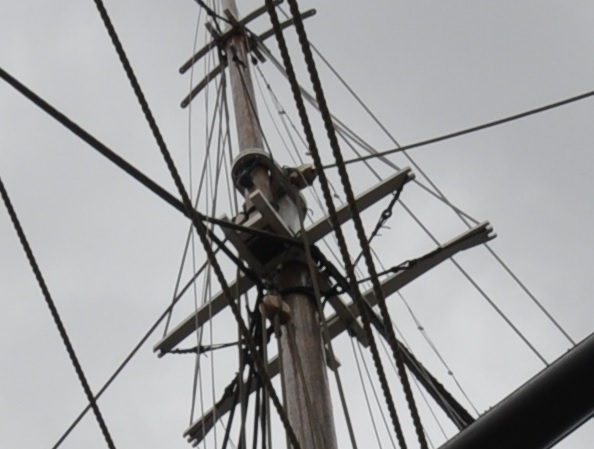
Anyway, it reminds me of the masts on the preserved U.S.S. Constellation. I guess it is the modeling gods’ way of telling me that it’s time to get back to work!
So its back on the job with the Constellation’s paint…
In what was apparently an attempt to simulate the look of oxidized copper cladding the ship carried when in service, Constellation museum staff have applied an absolutely GODAWFUL blue-green color the to the wood below the old waterline.
The copper that once graced the real hull is long gone, although the Pyro model shows it in place. If I stick to my plan to depict the ship as she appears today as a museum, the “copper” detail will have to be painted green. I mixed up a sample and placed it next to the model in an attempt to get into the idea, but it is so UGLY…
Ok, that hull green is just too awful - and historically questionable, at best!
The model will be a gift to my father as a memento of our visit to the U.S.S. Constellation museum, but I’m willing to bet he may not even remember that hull color anyway. Plus, he has a print of Constellation hanging in his workshop which shows the original copper hull:
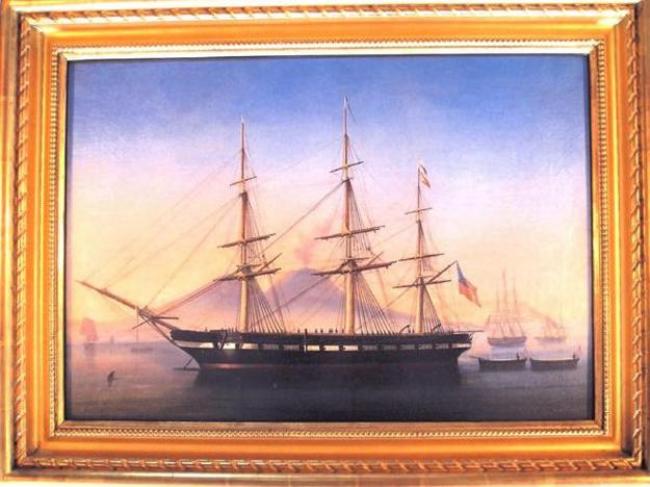
Good enough for me! I went ahead and shot the copper plating detail on the hull bottom with Tamiya acrylic Dark Copper (XF-28).
I was initially concerned that the metallic copper might be a little stark, but seeing it on the model I think that it will work just fine. It makes a pleasingly bright contrast to the drab colors of the rest of the ship. Anyway, that blue-green color would surely have been a cause of seasickness…!
When my dad and I visited the ship in 2010, there were quite a few historical displays on board:
Among my favorites was a sailor’s mess exhibit:
Yum!
I gave the guns and assorted detail bits a Winsor & Newton Burnt Sienna oil wash over their Tamiya acrylic base colors.
